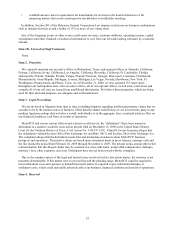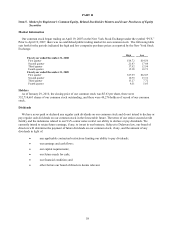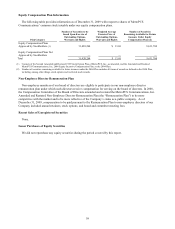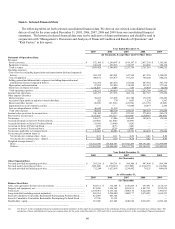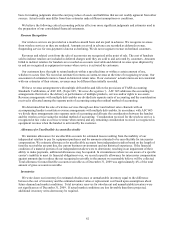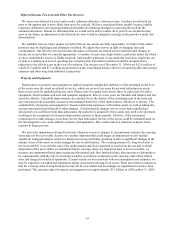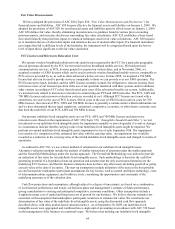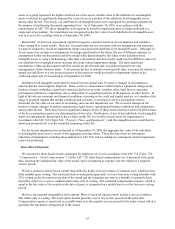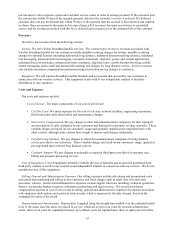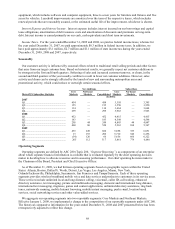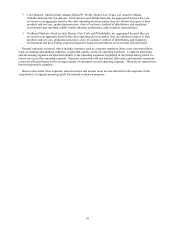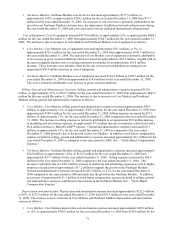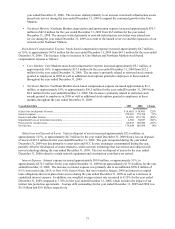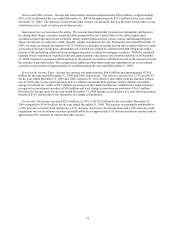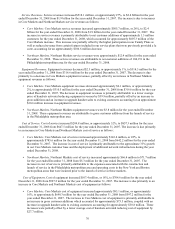Metro PCS 2009 Annual Report Download - page 78
Download and view the complete annual report
Please find page 78 of the 2009 Metro PCS annual report below. You can navigate through the pages in the report by either clicking on the pages listed below, or by using the keyword search tool below to find specific information within the annual report.
66
The determination of the fair value of stock options using an option-pricing model is affected by our common
stock valuation as well as assumptions regarding a number of complex and subjective variables. The Board of
Directors uses the closing price of our common stock on the date of grant as the fair market value for our common
stock. The volatility assumption is based on a combination of the historical volatility of our common stock and the
volatilities of similar companies over a period of time equal to the expected term of the stock options. The
volatilities of similar companies are used in conjunction with our historical volatility because of the lack of
sufficient relevant history equal to the expected term. The expected term of employee stock options represents the
weighted-average period the stock options are expected to remain outstanding. The expected term assumption is
estimated based primarily on the stock options’ vesting terms and remaining contractual life and employees’
expected exercise and post-vesting employment termination behavior. The risk-free interest rate assumption is based
upon observed interest rates on the grant date appropriate for the term of the employee stock options. The dividend
yield assumption is based on the expectation of no future dividend payouts by us.
The value of the options is determined by using a Black-Scholes pricing model that includes the following
variables: 1) exercise price of the instrument, 2) fair market value of the underlying stock on date of grant,
3) expected life, 4) estimated volatility and 5) the risk-free interest rate. We utilized the following weighted-average
assumptions in estimating the fair value of the options grants for the years ended December 31, 2009 and 2008:
December 31,
2009
December 31,
2008
Expected dividends..................................................................................................... 0.00% 0.00%
Expected volatility...................................................................................................... 50.01% 45.20%
Risk-free interest rate ................................................................................................. 1.99% 2.49%
Expected lives in years ............................................................................................... 5.00 5.00
Weighted-average fair value of options:
Granted at below fair value ....................................................................................... $ — $ —
Granted at fair value.................................................................................................. $ 6.43 $ 6.95
Weighted-average exercise price of options:
Granted at below fair value ....................................................................................... $ — $ —
Granted at fair value.................................................................................................. $ 14.23 $ 16.36
The Black-Scholes model requires the use of subjective assumptions including expectations of future dividends
and stock price volatility. Such assumptions are only used for making the required fair value estimate and should not
be considered as indicators of future dividend policy or stock price appreciation. Because changes in the subjective
assumptions can materially affect the fair value estimate, and because employee stock options have characteristics
significantly different from those of traded options, the use of the Black-Scholes option pricing model may not
provide a reliable estimate of the fair value of employee stock options.
Compensation expense is recognized over the requisite service period for the entire award, which is generally the
maximum vesting period of the award.
As share-based compensation expense under ASC 718 is based on awards ultimately expected to vest, it is
reduced for estimated forfeitures. ASC 718 requires forfeitures to be estimated at the time of grant and revised, if
necessary, in subsequent periods if actual forfeitures differ from those estimates. We recognized stock-based
compensation expense of approximately $47.8 million, $41.1 million and $28.0 million for the years ended
December 31, 2009, 2008 and 2007, respectively.
Customer Recognition and Disconnect Policies
Until January 2010, when a new customer subscribed to our service, the first month of service was included with
the handset purchase. Under GAAP, we are required to allocate the purchase price to the handset and to the wireless
service revenue. Generally, the amount allocated to the handset will be less than our cost, and this difference is
included in Cost Per Gross Addition, or CPGA. We recognize new customers as gross customer additions upon
activation of service. Until January 2010 we offered our customers the Metro Promise, which allowed a customer to
return a newly purchased handset for a full refund prior to the earlier of 30 days or 60 minutes of use. Customers
who returned their phones under the Metro Promise are reflected as a reduction to gross customer additions.
Customers’ monthly service payments are due in advance every month. Our customers must pay their monthly
service amount by the payment date or their service will be suspended, or hotlined, and the customer will not be able
to make or receive calls on our network. However, a hotlined customer is still able to make E-911 calls in the event
of an emergency. There is no service grace period. Any call attempted by a hotlined customer is routed directly to



